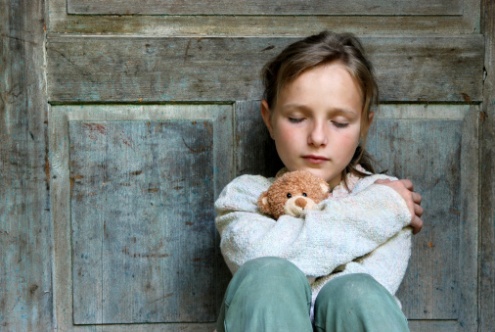Little Johnny was 11 years old and his homeless mother had his five year old younger sister to worry about. So she left him on a street corner in Ocean Beach, a neighborhood in San Diego, California. Johnny looked for his Mom for four days before he was picked up by social workers. During that time he scrounged odd jobs — including conning a restaurant manager into letting him wash dishes three hours a night. He had earned just over $135. When he was picked up she had every penny in his pockets, confining himself to one meal at the restaurant and provided by it, because “Mom needs it.” Johnny is a bright-eyed boy with above average intelligence. But he has a slight stoop due to a correctable bone malformation. His teeth have painful cavities. And he has not been in school for two years. He is a microcosm of child poverty in the United States — a child with strong potential and admirable character but with health problems, an educational deficit, and likely relegation either to group home foster care or back to the streets. Regrettably, Johnny S. is not unique. Indeed, he lives in our wealthiest state and until gathered up, was sleeping under bushes by the beach, in the shadows of $5 million homes.
Over the past two decades, child poverty has been fluctuating between 10% to 20% of the population, with an overall upward trend. The rate declined somewhat during the late 1990s, but are now trending back up. And it is happening in the context of a now limited and reduced welfare-reform safety net; (b) “severe poverty” (income under one-half of the federal poverty line) has increased but is not precisely measured — a problem Johnny S. represents; and (c) children in large numbers are living below or near the poverty line. This last grouping now represents well over 37% of all American children, 42% of America’s infants and toddlers, 58% of her African-American children, and 62% of her Latino children. ( See Reports of the National Center for Children in Poverty, Columbia University, www.nccp.org).
Child advocates are concerned about both ends of this spectrum – the severe poverty portending permanent damage, and the imminent creation of a large third-world underclass of intractable poverty. The latter concern is reflected in overall increasing income disparities, with the upper 1% of Americans now earning as much as the bottom 38% combined. And the concern is underlined by barriers to upward mobility driven not only by childhood poverty, but by preclusive real estate (and rent) inflation; growing energy, gasoline and health care costs, and little increase in higher education capacity (including community college and technical training) most will need for employment in the international economic labor niche of the United States. This effective contraction is joined by many years of tuition increases well above inflation. And impediments to mobility for these young include unprecedented economic solicitude for older adults. While the federal budget deficit appears to be laudably in decline, it is still quite high by recent historical records. Add to this sum more ominous Social Security and Medicare obligations — that expert economists now project over the next 70 years to reach well over $40 trillion, $120,000 for each child and youth obligated to pay for it for the children now being born. And that does not include the still formidable federal deficit, nor the surprisingly high public employee pension and medical coverage costs that have plagued Southern Europe and also threaten us. Here is the problem: Today’s liberals actually believe the pop song lyric “Money for Free and Chicks for Nothing.” The world will manage later on. Money will rain down the road. That is not how it works. Nor is the trend likely to improve given the power of the elderly politically, rather, the more likely future will be more subsidized operations and medicines to extend life by weeks or days, and higher social security benefits for more people. Child advocates increasingly cite our unique cross-generational taking: Instead of the longstanding American tradition of older adults investing in the young (particularly in opportunity for the impoverished), we are burdening them with our unprecedented debts and future costs.
Who are these children living near or below the poverty line? What are the causes of their poverty? What legal and societal remedies are available to give them realistic opportunity to advance?
Contrary to public perception, the parents of impoverished children are not consuming beer in front of soap operas — engaged in what some call “welfare as a way of life.” The data reveal that 56% of these low-income families have at least one full time working parent; 28% work part time and only 16% are unemployed — many of whom would be willing to work if employment were available (id.). However, the single most striking variable underlying child poverty is single-parenthood – both from divorce and unwed births — the latter have risen over the last thirty years from below 10% of all births to over 30%. And contrary to the common view, these births are not to teenagers, the vast majority are to adult women. Paternal support for these children is minimal, with average payments received amounting to less than $35 per month per child, and almost half of that goes not to families but to repay state and federal governments for welfare payments. (See Chapter 2, California Children’s Budget 2004-05, Children’s Advocacy Institute at www.caichildlaw.org). Most of the children in these unwed families live below the poverty line, and perhaps the most remarkable number from the U.S Census Population Survey reports is the difference between the median income of a female single head of household with two or more young children (about $11,000 in annual income), versus the median for those children in a family with a married couple (well over $50,000) (id.) These numbers have grown even more stark over the past 8 years.
The conundrum for Johnny S. is the need for two incomes to support high rents and other rising costs of living. His mother is caught between the rock of child care obligations for her children (which she either provides or finds $5,000 per child to finance) and the hard place of a single wage earner unlikely to net much more than her child care costs for two or more children. Current federal policy makes the hard place harder because she is limited to 60 months of federal help (Temporary Aid to Needy Families) — and even if working part-time is given no credit for those months of income where she works less than 32 hours. Remarkably, the Bush administration currently proposes a 40-hour minimum work week for such parents, with each month of full-time shortfall generating possible sanction — including the 60-month lifetime cut-off.
As discussed, child poverty involves both private decisions and public disinvestment. Hence, the causes as cited by commentators tend to turn on their respective political leanings, with conservatives citing reproductive irresponsibility, sexual license, lack of paternal commitment, as well as deficits and unfair burdens imposed on the young by the old and limiting their future aspirations. Liberals cite reduction of the safety net, a minimum wage that is not adjusted to inflation and has declined to below the poverty level for parents of two or more children, and education disinvestment that jeopardizes future employability for an impoverished class. Is it possible that both are correct?
According to many child advocates, the problem facing children is the truce silently in force between these traditional political antagonists. Each appears to have surrendered its agenda favorable to impoverished children in return for the surrender of the other’s. Hence, popular culture now purveys with impunity the notion that single parenthood is simply a different and somehow charming choice… with those dozens of sit-com and other adult-models (from Rachel on Friends to Roz on Frasier and many others) suffering no financial repercussions, child care dilemmas, or worries. It is far beyond the old sitcom character of Murphy Brown. Indeed, our fantasy parents in the media often do not seem to work for a living but the rent is magically paid. No male appears to pay child support, nor does any child appear to need it. Rather, our media flood us with sexual stimulation and commendation without apparent negative childbirth consequences, replete with cialis and viagra ads for hours of male hardening — while hypocritically eschewing condom ads. Child advocates contend that for their part, liberal adults have surrendered (or been overborne) in the direction of momentous public disinvestment in children, especially impoverished children – with safety net support and education opportunity suffering the largest cuts. And child advocates complain that both adult political groupings (although purportedly in “deep division”) have conspired to violate through deficits and huge obligations to the elderly the one pact always drawn in favor of children – that adults do not take from their children, but give to them.
So if these complaints have merit, what is the answer? One prescription is to reverse the trade-off between private license and child disinvestment into the opposite proposition, one demanded from the body politic. The Honorable Charles D. Gill has long advanced the public commitment part of it in a proposed constitutional amendment (Essay on the Status of the American Child — 2000 AD: Chattel or Constitutionally Protected Child-Citizen?, NACC Children’s Law Manual – 1998, at 337). Our constitution is oriented to inhibit the coercive power of the state vis-a-vis private, individual liberties. But the constitutions of most developed nations also interpose some affirmative obligations on the state — obligations which need not impede checks on state coercion. Similarly, the United Nations Convention on the Rights of the Child, now signed and ratified by every nation except the United States and Somalia, posit some minimal affirmative obligations to our children. Such a compact may properly specify only those obligations that are clearly commended as a common floor: That our children will not be homeless, will receive adequate care and nutrition to develop healthy brains, will have minimal health coverage, and educational opportunity so they may provide for themselves and their children in turn. What is the opposition to such a standard, spelled out with sufficient specificity to be enforceable? Is it that we, unlike our less affluent contemporaries in Europe, cannot afford it?
We reserve for our constitution measures that may be politically unpopular but are a consensus “rule of the game” underlying our society. Although denied “suspect class” status in equal protection cases, what group — in fact — is more politically impotent than impoverished children? And what commitment do we have more basic than this one?
Would support for such a formalized pledge benefit from a cultural sea change that private decisions to have children warrant the preparation and respect that the miracle of childbirth implies? That it include the simple and minimal obligation of parents simply to intend a child, and of a father to provide for his children? Assume such a commitment were an acknowledged part of our culture, and became as “politically incorrect” to transgress as would an insult to a homosexual or a wheel-chair confined adult. What would be the prospects for such a constitutional commitment, and to child investment in general, in such an altered environment?
One need not have a long conversation with Johnny S. to appreciate the merits of both a constitutional amendment and a cultural commitment to such children.
The author: Robert C. Fellmeth, is the Price Professor of Public Interest Law, University of San Diego School of Law


